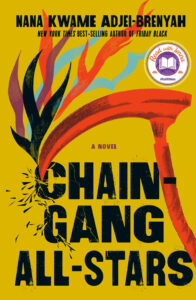 Chain-Gang All-Stars by Nana Kwame Adjei-Brenyah
Chain-Gang All-Stars by Nana Kwame Adjei-Brenyah Genres: Adult, Dystopian, Fiction, LGBTQ+, Speculative Fiction
Published by Knopf Doubleday Publishing Group on May 2, 2023
Format: Hardcover
Pages: 367

Two top women gladiators fight for their freedom within a depraved private prison system not so far-removed from America's own.
Loretta Thurwar and Hamara "Hurricane Staxxx" Stacker are the stars of Chain-Gang All-Stars, the cornerstone of CAPE, or Criminal Action Penal Entertainment, a highly-popular, highly-controversial, profit-raising program in America's increasingly dominant private prison industry. It's the return of the gladiators and prisoners are competing for the ultimate prize: their freedom.
In CAPE, prisoners travel as Links in Chain-Gangs, competing in death-matches for packed arenas with righteous protestors at the gates. Thurwar and Staxxx, both teammates and lovers, are the fan favorites. And if all goes well, Thurwar will be free in just a few matches, a fact she carries as heavily as her lethal hammer. As she prepares to leave her fellow Links, she considers how she might help preserve their humanity, in defiance of these so-called games, but CAPE's corporate owners will stop at nothing to protect their status quo and the obstacles they lay in Thurwar's path have devastating consequences.
Moving from the Links in the field to the protestors to the CAPE employees and beyond, Chain-Gang All-Stars is a kaleidoscopic, excoriating look at the American prison system's unholy alliance of systemic racism, unchecked capitalism, and mass incarceration, and a clear-eyed reckoning with what freedom in this country really means.
One part dystopian speculative science fiction, one part social commentary on systemic racism and the flawed American prison system, Nana Kwame Adjei-Brenyah’s Chain-Gang All-Stars is an ambitious narrative that attempts to cover a lot of ground in <400 pages. Despite the book’s summary focusing on Loretta Thurwar and her survival with her partner and fellow chain member Hamara Staxxx, Chain-Gang All-Star reads more like a collection of short stories. Loretta and Hamara’s narrative only make up about 1/3 of the book’s content, the rest is devoted to over a dozen different characters and various perspectives covering the CAPE program. These perspectives include those of program participants, show producers, host and commentators, prison staff, abolitionist protestors, viewers, etc. The large scope of these various characters and the ambition behind Adjei-Brenyah’s commentary is ambitious and is well-designed to spark open conversations about topics in the book. Despite the great intention and ambition behind its pages, unfortunately I found the actual novel/story portion of the book to be disjointed and difficult to get into.
For me, Chain-Gang All-Stars is at its best when it focused on Thurwar and Staxxx’s experiences which are compelling and interesting. The character psyche and gray morality of various participants (as well as viewers who are frankly obsessed with watching inmates kills each other with government permission for sport) to be the best part of the book. Both are well aware of their situations but their differences in outlook and personality makes their dynamic all the more interesting once its revealed someone on their team was murdered out of the blue. Thurwar takes the tough, internalized pain approach to minimize the damage to others while Staxxx has her emotions on full display, acting as a sort of empathic martyr to others around her. There are many footnotes included highlighting real-life facts and laws pertaining to the American justice system and moments clearly written for the abolitionist movement and these factual notes have the biggest impact when related to the affected characters involved.
Where the novel and reading experience gets a bit muddy is when its perspective and narrative shifts constantly amongst minor characters. Unlike other novels that feature a large ensemble cast woven seamlessly into the main narrative, Chain-Gang All-Stars feature many chapters of one-off characters who show-up, make a point to spark a conversation, and then are quickly forgotten for new characters (or a few like the scientist Patty has such a brief appearance later in the book, it feels more like a cameo easter egg than an intentional appearance). When the character and content are strong (as in the case of Sports caster Tracy Lasser’s chapter involving activism, sexism and influence), the world within and around the CAPE program feels complex, nuanced, and immersive. More often than not however, many of these shifting chapters feel more like passing vignettes that lessen the emotional impact and voice of the book. In particular, a good number of chapters are devoted to another inmate named Hendrix Young. I believe his story is meant to show why prisoners turn to the CAPE program as a means of escape (or in his case salvation) and to empathize with his chain/team. However, his content sits in an awkward realm of not being enough for me to care about his journey and team, and being too much hindering/distracting from Thurwar’s story. Adjei-Brenyah acknowledged that the story of Chain-Gang All-Stars was expanded from a short story intended for his previous short story collection Friday Black. Many of Chain-Gang All-Stars perspectives feel like they would be better utilized in a short story collection similar to Friday Black rather than being interlaced and framed around the main narrative that subsequently feels underdeveloped from a plot-perspective.
The other drawback for me was the ending. Without giving away any spoilers, it felt abrupt and lacking some sort of resolution or insightful reflection. Nearly every chapter introduces important topics that go beyond the plot when taken at face value. Even when the book asks questions that it doesn’t have an answer to, it delivers some type of commentary that is either inspiring the reader to act or to highlight injustices commonly overlooked. The plot throws constant obstacles Thurwar’s way to prevent her from being freed and to put her chain in an impossible position. With such a strong lead up (and introspection) to the final match appearance, the actual ending sequence feels like it was cut short in a way that’s both open-ended and unsatisfying for her character. A certain character’s death feels like it was meant to be moving or emotional based on the number of pages that were devoted to their journey, but for me the actual scene fell quite flat. Again, this wouldn’t necessarily be a problem if there was some reflection or an important talking point introduced. The lack of strong message and an unresolved character narrative felt like both aspects were left hanging.
Ultimately this is one of those books that I wanted to like a lot more than I actually did. The ambition and message elevate the book to be so much more than the typical survival game trope that often relies on violence and shock value to be entertaining. There are also moments that are powerful coupled with real current and historical references for greater relevancy. Yet the execution of the actual plot and ending left a lot to be desired from a novel-reading perspective, reading more like an inspiring abolitionist movement piece. That’s a wonderful message and experience if that’s what you’re looking for. If the ending doesn’t have a strong conclusion, I want at least more plot so this wasn’t for me despite my appreciation and respect for the material.
